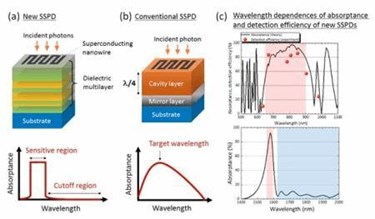Japanese Scientists Build Versatile Superconducting Nanowire Single-Photon Detector With Dielectric Multilayer
By Jof Enriquez,
Follow me on Twitter @jofenriq

Japan's National Institute of Information and Communications Technology (NICT) has devised a flexible optical design method for superconducting nanowire single-photon detectors (SSPDs or SNSPDs) that is more efficient at counting individual photons than conventional SSPDs.
Superconducting nanowire detectors are able to count nearly a billion photons per second, and they operate over a large range of wavelengths, have low dark (false) counts, and produce strong signals, especially at telecom wavelengths. Conventional SSPDs usually are made up of a simple cavity structure, consisting of dielectric resonant layers with a mirror layer, and can achieve high absorptance at the target wavelength.
However, such structures are not ideal in building detectors with high efficiency over a carefully controlled spectral range, with rejection at other wavelengths, which are functionalities desirable for emerging applications in the life sciences and atmospheric remote sensing.
In order to improve high detection efficiency, Japanese scientists have developed a new device structure with a non-periodic dielectric multilayer (DML) structure to achieve a flexible design for the visible to near infrared spectrum.
For the dielectric multilayer (DML), silicon dioxide (SiO2) and titanium oxide (TiO2) were used, and the niobium nitride (NbN) superconducting nanowire was put on the dielectric multilayer.
"By optimizing the thicknesses of each dielectric layer in the DML, one can design the required wavelength dependence of the optical absorptance in the superconducting nanowire. Advantage of the SSPD with non-periodic DML is that one can achieve the various wavelength dependences such as wider or narrower bandwidth and/or an intrinsic bandpass filter to minimize the effect of blackbody radiation, pump- or stray light without changing the basic device structure," the scientists wrote in the paper, published in Scientific Reports.
"Regarding the optical design method, in order to optimize the wavelength dependence of the absorptance effectively, we perform two-step simulation of the optical multilayer calculation and the finite element analysis," they said in a news release.
For their experiment, "two different spectra were designed with target windows of 650–900 and 450–600 nm. We fabricated SSPDs based on the two designs and evaluated the system detection efficiency for incident photons across a range of wavelengths. As a result, we found that the obtained detection efficiencies for each wavelength were consistent with the simulated wavelength dependencies of the optical absorptance," according to the paper.
The newly-developed technique can be applied for wide wavelength regions between ultraviolet and mid-infrared, and are excellent for applications that require high efficiency over a precise spectral range and strong signal rejection at other wavelengths, such as in quantum cryptography, quantum computing, fluorescence spectroscopy in the life sciences, secure communications, and atmospheric remote sensing.
The study was conducted by NICT, Japan’s sole independent administrative institution specializing in the field of information and communications technology, in collaboration with Osaka University and the University of Glasgow.
